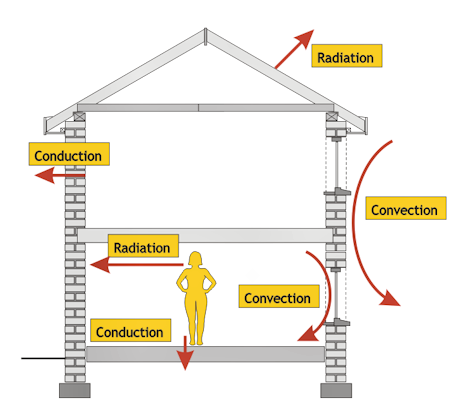Insulation - Principles and Calculations
1 Heat Transfer
Heat is transferred because a material will attempt to achieve thermal equilibrium with its surroundings. Heat flow will occur within a material (solid, liquid or gas) or between materials until the temperature of each is equal. Heat transfer will occur through three mechanisms which might operate alone or in combination. These are conduction, convection and radiation.
| Conduction: This is where heat energy is transferred because of the physical
contact between molecules within a material (or between materials that are
touching each other). The direction of flow will be from the warm area to the
cool area. Thermal conductivity is the rate of heat flow - a factor which is
determined by the ability of the molecules to conduct heat. The human body is
sensitive to this heat flow rather than to temperature. If a person stands in
bare feet on a concrete floor, and then a wooden one, the body will sense the
different rates of heat flow. That is, heat will be transferred from the body to
the concrete more quickly than to the wooden floor because concrete is a better
conductor. The concrete floor will be less thermally comfortable than the wooden
one, although, in fact, a ground bearing concrete floor usually offers better
thermal insulation.
Convection: Convection refers to heat being transferred by the movement of a fluid. In buildings the fluid in question is usually air or water. When it comes into contact with a warmer or colder surface the air or water will either absorb heat (from a colder surface) or lose heat (to a warmer surface). If it becomes colder the fluid will sink because of its increased density and vice versa. Radiation: Heat can also be transferred through the air (or rather through space) from one body to another by radiation. Heat is radiated to and absorbed from the surfaces that surround a body without heating the air. When radiant energy hits a body some of the energy is reflected and some is absorbed (the respective amounts will vary between different materials and, for instance, colour will play a significant role in determining the amount reflected). In a typical small detached house with one-brick solid walls, timber ground floor, uninsulated roof and single glazing approximately 25% of the heat goes through the roof, 30% through the walls, 15% through the windows, 15% through the floor, and 15% through ventilation and draughts. |
 |
Buildings and People
Buildings will lose heat by all three means. Heat will be conducted from the interior to the exterior through walls, floors and the roof. Convection can transfer heat from a warm interior cavity skin to the cooler outer skin and the wind will convect heat away from exterior surfaces of the building. The exterior surfaces of the building will radiate heat to its surroundings. Human beings will also lose and gain heat by these mechanisms. They will lose heat by conduction when they stand on a cold floor, by convection because of draughts and by radiation to cold surfaces such as windows or uninsulated walls.
Thermal Mass
This refers to the amount of heat a material can store. A so-called heavyweight building will have a high thermal mass. High thermal mass can be useful in smoothing out fluctuations in temperature. Rooms with a high mass will heat up slowly and cool down slowly. Thermal mass can be useful in storing solar energy coming in through southerly orientated windows.
except where acknowledged